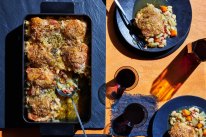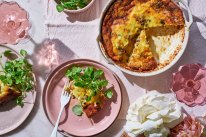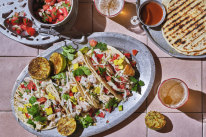Curtis Stone’s golden party pies have a secret ingredient that make them even better
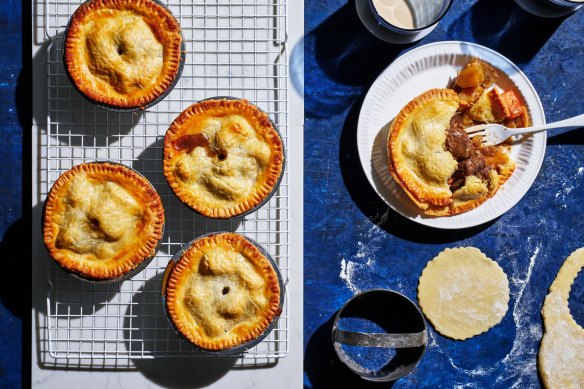
These hearty treats – all melt-in-the mouth, flaky deliciousness and rich, chunky filling – will warm the cockles of your heart, to be sure. Enjoy with a Guinness while you’re cooking!
The beef stew can be made up to 2 days ahead, cooled, covered, and refrigerated.
Ingredients
Beef stew
900g beef chuck casserole steak, cut into 3cm pieces
¼ cup olive oil
6 garlic cloves, finely chopped
1 litre (4 cups) reduced-salt beef stock
500ml (2 cups) water
250ml (1 cup) Guinness stout
250ml (1 cup) red wine
1 tbsp sugar
1 tbsp Worcestershire sauce
1 tbsp fresh thyme leaves
2 fresh bay leaves
40g butter
1 brown onion, diced
2 carrots (about 125g), cut into 1.5cm pieces
1 parsnip (about 100g), cut into 1.5cm pieces
1kg brushed potatoes, peeled and cut into 1.5cm pieces
Pie dough
2½ cups plain flour, plus more for dusting
3 tsp sugar
½ tsp fine sea salt
250g cold unsalted butter, cut into 1cm cubes
about ⅓ cup ice water
To assemble pies
plain flour, for dusting
1 large egg
1 tbsp cream
Method
To make the beef stew
Step 1
Season the beef with salt and pepper. Heat the oil in a large pot over medium-high heat. Add the beef in a single layer and sear, turning as needed, for 8 minutes, or until it is browned all over.
Step 2
Add the garlic to the beef and cook for 30 seconds, or until fragrant. Add the broth, water, Guinness, wine, sugar, Worcestershire, thyme and bay leaves. Stir to combine. Bring the mixture to a simmer, cover and cook for 1 hour, stirring occasionally.
Step 3
Meanwhile, in a medium frypan over low-medium heat, melt the butter and saute the onion, carrot and parsnip for 15 minutes, or until the onion is golden. Remove the vegetables from the heat and set aside.
Step 4
After the beef has cooked for 1 hour, stir in the sauteed vegetables and diced potato. Simmer the stew, uncovered, for 40 minutes, or until the beef and vegetables are tender.
Step 5
Discard the bay leaves, tilt the pan, and spoon off any excess fat that rises to the top of the cooking liquid. Using a slotted spoon, transfer the beef and vegetables to a shallow baking dish, being careful not to break up the meat. Over medium heat, simmer the remaining cooking liquid for 20 minutes or until reduced to a sauce consistency. Season the sauce with salt and pepper and pour over the beef and vegetables. Set the mixture aside to cool completely.
To make the pie dough
Step 1
While the beef is stewing, combine the flour, sugar and salt in a food processor and pulse to blend. Add the butter and pulse about 10 times, or until the butter is in pea-size pieces; do not over-process. While pulsing the processor, add ⅓ cup of ice water, then pulse just until the dough forms moist clumps. If necessary, add more water 1 tablespoon at a time.
Step 2
Transfer the dough to a work surface and divide it in half. Divide each piece of dough into 6 pieces (12 in total) and shape into discs. Wrap each piece individually in cling film and refrigerate for at least 30 minutes before rolling it out.
assembling and baking the pies
Step 1
Position the rack on the lowest rack of the oven and set a baking tray on the rack. Preheat the oven to 180C fan-forced (200C conventional).
Step 2
On a floured work surface, roll out 1 disc of dough to a 15cm round about 2.5mm thick. Line a 12cm disposable aluminium pie tin with the dough disc. Repeat with the remaining 5 dough balls and pie tins. Divide the cooled stew among the pans, using about ¾ cup of filling for each pie.
Step 3
Roll the remaining 6 dough pieces out into 15cm rounds and place them over the filling. Trim the dough overhang to 1cm. Pinch the bottom and top crusts together to seal, and fold them under. Crimp the edges. Using your finger, make a hole in the centre of each top crust.
Step 4
In a small bowl, whisk together the egg and cream to blend. Using a pastry brush, lightly brush the tops of the pies with the egg-cream mixture.
Step 5
Place pies on the preheated baking tray in the oven and bake for 40 minutes, or until the crust is deep golden and the filling is bubbling. If the crust begins to brown before the filling bubbles, tent the pies with foil. When cooked, remove from the oven and let the pies cool for a few minutes on a wire rack until warm before serving.
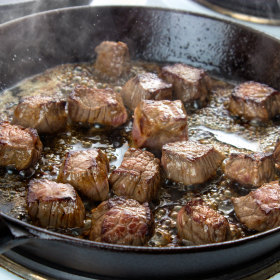
Tips and tricks
- The perfect sear
Searing the meat forms a delicious crust and creates tasty brown bits on the bottom of the pot called a “fond” that helps enrich your braise tremendously. Moisture is the enemy of a good sear, so dry the meat thoroughly before searing. - Don’t overcrowd the pot
Add a splash of oil to skim the surface of the pot. Add the meat; you should hear it sizzle. If you’re searing bite-size pieces of meat for stews, add only enough meat to form a single layer with about 2cm of space around each piece. The meat won’t brown if the pot is overcrowded. - Let the stew rest
Always cool the braised meat in its braising liquid. This will allow the meat to reabsorb some of the liquid that it lost during the cooking, making the meat more moist. - Flaky v tough pie dough
The secret to the flakiest pie dough is to avoid blitzing your butter to smithereens in the food processor. Leaving pea-size pieces of butter in the dough is key because they will melt in the oven and release water, which will become steam. The steam helps to puff up the dough and contributes to that melt-in-your-mouth texture. - No soggy bottoms
No one likes a soggy pie bottom. To avoid this, bake the pies on the bottom oven rack. Being close to the heat source will help the bottom crusts bake and brown properly. This also keeps the top crust farther away from the top heating elements, which helps it to brown more gradually and evenly throughout baking.
Appears in these collections
The best recipes from Australia's leading chefs straight to your inbox.
Sign up- More:
- Classics with Curtis
- Beef
- Pastry
- Potato
- Irish
- Savoury pies & tarts
- Main course
- Entertaining
- Father's Day
- Comfort food
- Family meals
- Winter warmer
- Winter
- Kid-friendly
From our partners
Similar Recipes
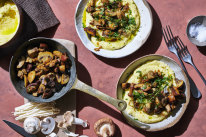
‘The perfect meat-free main’: Curtis Stone’s creamy polenta with braised mushrooms
- 30 mins - 1 hr
- Curtis Stone
More by Curtis Stone

‘The perfect meat-free main’: Curtis Stone’s creamy polenta with braised mushrooms
- 30 mins - 1 hr
- Curtis Stone

